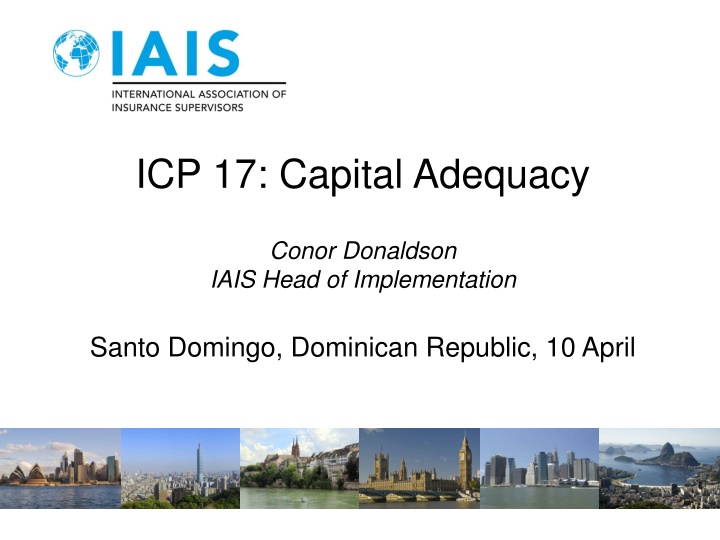
Insurance Core Principles and Capital Adequacy
Explore the essential elements of insurance supervision, including the Proportionality Principle, thematic organization of Insurance Core Principles (ICPs), and the importance of capital adequacy. Learn about the requirements, standards, and high-level principles that guide insurance supervisors in maintaining the stability and integrity of the insurance industry.
Download Presentation

Please find below an Image/Link to download the presentation.
The content on the website is provided AS IS for your information and personal use only. It may not be sold, licensed, or shared on other websites without obtaining consent from the author. If you encounter any issues during the download, it is possible that the publisher has removed the file from their server.
You are allowed to download the files provided on this website for personal or commercial use, subject to the condition that they are used lawfully. All files are the property of their respective owners.
The content on the website is provided AS IS for your information and personal use only. It may not be sold, licensed, or shared on other websites without obtaining consent from the author.
E N D
Presentation Transcript
ICP 17: Capital Adequacy Conor Donaldson IAIS Head of Implementation Santo Domingo, Dominican Republic, 10 April
1.ICPs, Elements, and Hierarchy 2.Proportionality Principle 3.ICP 17 2
ICPs: Elements & Hierarchy The Principle Statement : the essential elements that must be present in the supervisory regime Insurance Core Principle Should be adhered to by all insurance supervisors Basis from which standards are developed High-level requirements that are fundamental to the implementation of the ICP Standard Written as obligations of the supervisor Linked to specific ICP Supports the core principle and standards and provides additional interpretation or detailed guidance on how to comply with or implement the standard Guidance Does not set out new requirements Often provides examples of possible ways of implementing the requirements in the standard/principle statement 3
Thematic Organisation of ICPs 26 Insurance Core Principles Supervisory Process, Preventive and Corrective Measures, and Winding- up Group Supervision, Cross Border Cooperation and Crisis Management Supervisory Objectives and the Supervisor Insurer Licensing, Suitability and Control Insurer Governance and Internal Control Market Conduct and Financial Integrity Solvency Regime ICP 7 Corporate Governance ICP 9 - Supervisory Review and Reporting ICP 1- Supervisory Objectives ICP 4 Licensing ICP 13 Reinsurance ICP 18 Intermediaries ICP 22 - AML CFT ICP 8 Risk Management and Internal Controls ICP 10 - Preventative and Corrective Measures ICP 23 - Group Wide Supervision ICP2 The Supervisor ICP 5 Suitability of Persons ICP 14 Valuation ICP19 Conduct of Business ICP 3 Info. Exchange and Confidentiality ICP 24 - Macro prudential Surveillance ICP 6 - Control ICP 11 - Enforcement ICP 15 Investment ICP20 Public Disclosure ICP 25 - Supervisory Cooperation and Coordination ICP 16 - ERM for Solvency Purposes ICP 12 - Winding-up and Exit ICP21 Countering Fraud ICP 26 Cross Border Crisis Management ICP17 - Capital Adequacy 4
ICPs: Proportionality Principle Understand the objective of the supervisory measure Not go beyond what is necessary to achieve the objectives Tailored to the nature, scale and complexity of individual insurers and of the insurers business/risks (and potential risks) 5
ICP 17: Principle Capital adequacy requirements To provide for degrees of supervisory intervention To absorb insurer s significant unexpected losses 6
ICP 17: crucial standards Total balance sheet approach Different degrees of intervention All relevant and material categories of risk addressed The use of internal models Regulatory capital requirements Capital resources Criteria for assessing the quality and suitability of capital resources 7
Total balance sheet approach Determination of an insurer s capital for solvency purposes should be based upon all assets and liabilities, as measured in the regulatory balance sheet of the insurer, and the way they interact (i.e., determination of capital takes account of both asset-side and liability-side risks). Assets Liabilities TBSA Regulatory capital requirements Capital resources 8
Solvency control levels and regulatory capital requirements 9
Different degrees of intervention No supervisory intervention Compliance with PCR Supervisory intervention Restore capital resources or reduce the level of risk Breach of PCR Stronger supervisory actions Stopping the insurer s activities, withdrawal of the insurer s license, requiring insurer to close new business and run-off portfolio Breach of MCR 10
All relevant and material categories of risk addressed Dependencies and interrelations between risks Allowance for risk mitigation Transparency in recognition of risks in regulatory requirements Treatment of risks difficult to qualtify 11
Internal models Full or partial internal model Prior supervisory approval Documentation Use test IM fully embedded into the insurer s risk strategy and operational process Board and Senior Management have overall control of and responsibility for the construction and use of IM for risk management purposes 12
Conclusions Significant interdependencies between ICPs Important to consider market setup, preconditions, and supervisory objectives in establishing requirements DO NO MORE THAN NECESSARY TO ACHIEVE THE OBJECTIVE ICP 17 establishes high level requirements for capital adequacy, but also need to think about Reinsurance Valuation Investment Enterprise Risk Management 13
Contact information Conor Donaldson Head of Implementation International Association of Insurance Supervisors Centralbahnplatz 2 c/o BIS tel: +41 61 280 8602 mobile: +41 76 350 8602 Skype: conordonaldson e-mail: conor.donaldson@bis.org 14












